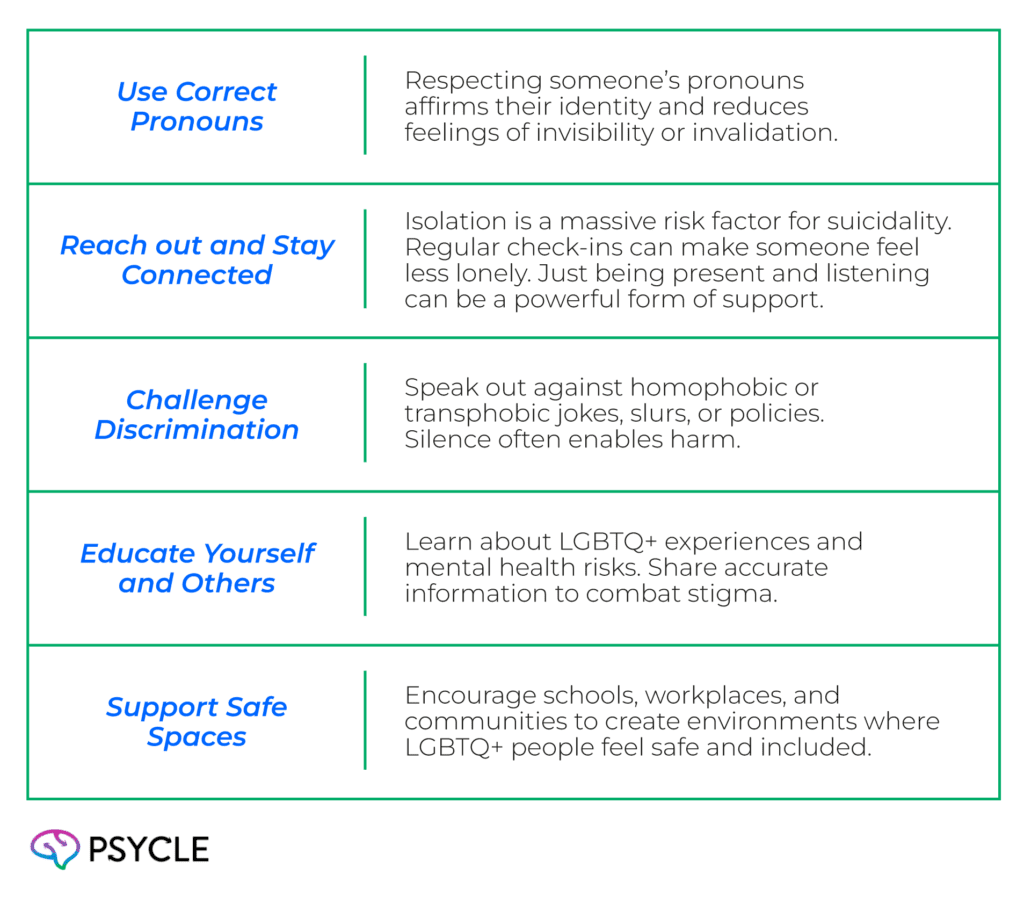Suicide rates are significantly higher among LGBTQ+ individuals, reflecting deep and ongoing challenges faced by many in this community. While every person’s journey is unique, shared experiences, such as intolerance, rejection, and feeling unsafe, can contribute to worsened mental health and suicidality.
In this article, we’ll explore the data surrounding LGBTQ+ suicide rates, examine the factors that contribute to this risk, and highlight ways we can support and protect the mental health of LGBTQ+ people.
Key Takeaways
- LGBTQ+ individuals face significantly higher suicide rates due to factors like discrimination, rejection, and isolation.
- Understanding the root causes, such as unsafe environments and a lack of support, can help us respond with compassion and action.
- Support is available through crisis lines, counseling, peer groups, online communities, and local LGBTQ+ events.
- Allies can help by educating themselves, supporting inclusive policies, and amplifying LGBTQ+ voices.
LGBTQ Suicide Statistics
LGBTQ+ covers a range of minoritised gender and sexual identities, including lesbian, gay, bisexual, transgender, queer, nonbinary, asexual, intersex, genderfluid, and more.
Despite efforts for greater inclusion, these individuals continue to face stigma and discrimination, contributing to a greater risk of mental health challenges. The LGBTQ+ community has a disproportionately higher rate of anxiety and depression compared to the general population, and suicidal ideation.
This increased risk is particularly prevalent in LGBTQ+ teenagers and young adults. In one analysis, 48% of bisexual high school students had seriously considered suicide, 40% had made a plan for how they would attempt suicide, and 27% had attempted suicide.
The data came from the U.S. Centers for Disease Control’s (CDC) biannual surveys. The same dataset found that 37% of gay or lesbian young people had seriously considered suicide, compared to 14% of straight youth.
Transgender people may be at an even higher risk. A 2020 peer-reviewed study published in the Journal of Adolescent Health found that transgender and nonbinary youth were 2 to 2.5 times more likely to consider suicide than their cisgender LGBQ peers.
However, it’s not just young LGBTQ+ people who face these struggles. In a survey study of 10,443 UK adults, researchers found that lesbian and gay adults were twice as likely to report past-year suicidal thoughts as heterosexuals.
Between 32% and 50% of transgender adults have attempted suicide, according to a review of studies from around the world.
What Drives Suicide Risk in LGBTQ Communities
One major reason for high suicide rates is discrimination, being mistreated for belonging to a particular group of people. Discrimination can take many forms, like verbal harassment, bullying, denial of services, or even physical violence.
These experiences can happen anywhere: at school, at work, at home, or in public. They often damage a person’s self-esteem and sense of identity.
Some LGBTQ+ people lose support from family or friends when they come out. Some are kicked out of their homes or lose their jobs. These factors cause isolation and loss of security, worsening mental health. People may also feel unsafe reaching out for support, which prevents them from getting help when needed.
How Anti-LGBTQ+ Laws Worsen Mental Health
Laws can make life harder or easier for LGBTQ+ people, with rules that block LGBTQ+ people from equal rights. Some countries have more extreme rules, banning same sex marriage and forms of gender expression.
In the US, laws have been passed that are more subtle but still extremely harmful in recent years. These include bans on gender-affirming care, books with LGBTQ+ titles, and rules limiting what teachers can say.
Between 2018 and 2022, 48 anti-transgender laws were enacted in the U.S. across 19 different state governments. During these years, past-year suicide attempts among transgender and non-binary young people increased by 72%.
Even when anti-LGBTQ+ laws do not pass, the debate around them can cause harm. When public leaders speak against LGBTQ+ people, it can feel like a personal attack.
Governments have a duty to protect the rights and well-being of all citizens, including LGBTQ+ individuals. Instead of passing harmful or exclusionary legislation, governments should focus on bills that affirm the dignity, rights, and freedoms of LGBTQ+ people. These could include anti-discrimination laws, inclusive healthcare policies, and protections for trans and nonbinary individuals.
As members of the public, we can support LGBTQ+ rights by educating ourselves on discriminatory laws, joining advocacy groups and campaigns that promote equality, and voting for inclusive leaders.
Suicide Prevention in LGBTQ+
Support and understanding from the public can be lifesaving for LGBTQ+ individuals. Here are some meaningful ways to help reduce suicide risk:

Support Networks and Crisis Resources
If you or someone you know is struggling with thoughts of suicide, please know that you are not alone, and support is available.
The Trevor Project is a leading suicide prevention organisation in the U.S., focusing on LGBTQ+ young people. They provide a 24/7 crisis support hotline and online social communities for people between 13 and 24 to connect with others experiencing similar struggles.
The TransLifeline is a trans-run grassroots organisation that operates a crisis phone line in the U.S. and Canada. It also provides microgrants to help trans and nonbinary people access legal support and gender-affirming hair removal.
The Samaritans offer instantaneous crisis support over the phone in the U.S. and other countries. They don’t focus specifically on LGBTQ+, but have responded to over 70,000 calls relating to sexuality and gender identity in the UK and Ireland alone.
Aside from these crisis lines, you may be able to access free LGBTQ+ support groups in your local area and online. You can also look into other LGBTQ+ events in your local area, such as choirs, gardening groups, yoga classes, and more. By connecting with like-minded people, you may feel less alone in your struggles.
There are also special counselling services for people facing challenges related to gender and sexuality, including both personal and group support.
Final Thoughts
LGBTQ+ suicide rates remain higher than those in the general population. These rates connect to unfair treatment, rejection, and a lack of safe spaces. But change is possible. Supportive environments, fair laws, and trained professionals can lower the risk.
If you or someone you know needs help, reach out. Support is available.
FAQs
What Should I Do if I Feel Like I Can’t Talk to Anyone About What I’m Going Through?
It’s common to feel afraid to open up. If talking to friends or family feels unsafe, consider reaching out to an anonymous support line or joining an LGBTQ+ peer group online. Sharing your thoughts with someone outside your immediate circle can be the first step toward healing.
Where Can I Find Out About LGBTQ+ Events in My Area?
You can type LGBTQ+ events followed by your area into your search engine. Social media platforms like Facebook, Instagram, and Meetup also have pages and groups dedicated to LGBTQ+ events in specific regions. If you’re in school or university, campus LGBTQ+ clubs often organize gatherings and can point you to nearby events. You may need to commute to a bigger area if you’re in a small village or town. However, once you have the confidence, you could always consider starting your own LGBTQ+ events.
Remember, not all events suit everyone. As such, don’t give up on hope if you attend an event and don’t enjoy it or feel connected to the people there. There will be plenty more to try.
Sources
- https://www.thetrevorproject.org/resources/article/facts-about-lgbtq-youth-suicide/
- https://www.samaritans.org/about-samaritans/research-policy/lgbtq-communities-and-suicide/
- https://www.mentalhealth.org.uk/explore-mental-health/statistics/lgbtiq-people-statistics
- https://www.amnesty.org/en/what-we-do/discrimination/lgbti-rights/

